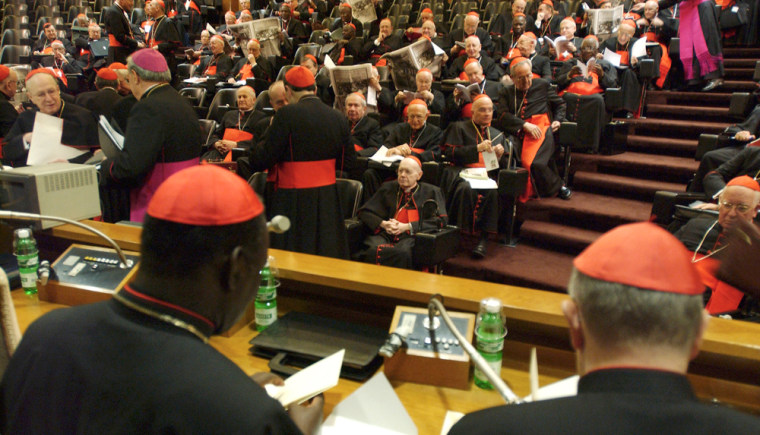It begins with a vow of secrecy and ends with a simple affirmation that opens the new papacy: “I accept.”
What happens in between is never fully known except by the cardinals who enter the Sistine Chapel, pray for divine guidance, then shut themselves off from the world until they choose a pontiff. On Monday, the oak doors will seal off papal electors for the first time in a generation.
And the largest and most international conclave in history will start casting small paper ballots for the successor to John Paul II.
No one can predict how long it will take. But how the 115 cardinals from 52 nations will go about it leaves little guesswork. The conclave’s rituals and rules are a clearly defined — from matters as pivotal as the voting process to minutia such as the plate used to transfer the folded ballots into an urn.
“There are those who feel the conclave process is archaic and in need of openness. Others think it’s a venerable institution that must be preserved,” said the Rev. Joseph Koterski, a professor of philosophy and religious history at Fordham University in New York. “Take your pick.”
There has been one nod to modern realities, however. The Vatican has expanded its list of forbidden items to include cell phones and electronic agendas, in addition to publications, television or radio.
It also has offered observers a break: promising to ring bells to announce the election along with the traditional plume of white smoke, which in the 1978 election of John Paul I came out gray and sent reporters into fits of indecision.
Messy history
But that’s just a blip in the messy history of conclaves.
In the 13th century, angry locals in Viterbo north of Rome removed the roof of the cardinals’ meeting hall and threatened to slash food rations to break a deadlock surpassing three years. In 1623, eight cardinals died of malaria during a midsummer conclave in Rome that lasted 19 days.
Now most cardinals can get to Rome in a matter of hours. But in 1914, when they had to cross the Atlantic by sea, the cardinals from Boston, Baltimore and Quebec arrived only in time to hear the news of Pope Benedict XV’s election. Eight years later, the same Boston and Quebec cardinals again reached Rome too late. The Philadelphia cardinal was also in tow.
It must have stung. Picking the pope is the single, essential duty of being a cardinal, a rank bestowed by the pontiff. It’s also the waiting room for leadership of the church. The last time the cardinals looked outside their elite fraternity for a pontiff was in 1378, when they picked Urban VI, a Vatican official.
On Monday, the cardinals — in their scarlet waist sashes and pectoral crosses — will gather first in St. Peter’s Basilica for a special Mass known as “Pro Eligendo Papa,” or “For Electing a Pope.” It will be their last public appearance.
Later in the day, the papal electors — cardinals under 80 years old — gather in the Pauline Chapel, chanting the Latin hymn “Veni Creator,” then move into the Sistine Chapel.
There — under Michelangelo’s “Creation” — each cardinal places his hand on the Gospels and pledges “with the greatest fidelity” never to reveal the details of the conclave. To do so could bring the ultimate sanction: excommunication.
A meditation is offered on the qualities needed for the next pope and the challenges ahead for the church. “Extra omnes,” an official then cries — Latin for “all out.” Everyone except the cardinals leaves and the voting can begin.
Just one ballot is expected on Monday. Each cardinal writes his choice on a paper inscribed with the words “Eligo in summen pontificem,” or “I elect as Supreme Pontiff.” They approach the altar one by one and say: “I call as my witness, Christ the Lord who will be my judge, that my vote is given to the one who, before God, I think should be elected.”
The folded ballot is placed on a round plate and slid into an oval urn designed by Italian artist Cecco Bonanotte. In the past, a single chalice was used to hold the ballots. But conclave changes made by John Paul II in 1996 required three vessels: one for ballots, another for ailing cardinals at the Vatican who can vote from their beds and the third to hold the ballots after counting.
The ballots are then bound together with a needle and thread — each pierced through the word “Eligo” — and burned along with a chemical to produce either black or white smoke.
Up to four rounds of voting are allowed each day and initially a two-thirds majority is needed. Under John Paul’s revisions, the threshold drops to a simple majority in the second week.
Electors reside throughout the conclave in the new Domus Sanctae Marthae, a hotel-style facility within the Vatican with 108 suites and 23 single rooms. The cardinals can meet privately when not voting.
Moving quickly
No conclave in the past century has lasted more than five days. The 1978 election of John Paul II took eight ballots over three days.
Once a winner emerges, events move fast.
The cardinal says “Accepto,” or “I accept,” his first words as pontiff.
He then dons the white robes of his new office, choosing from three sizes, and the papal tailor is summoned to make adjustments. At some point, bells ring.
A senior cardinal then heads to the central window of St. Peter’s Basilica. He makes a brief announcement that ends: “Habemus papam” — “We have a pope.” The next figure at the window will be the new pope.
